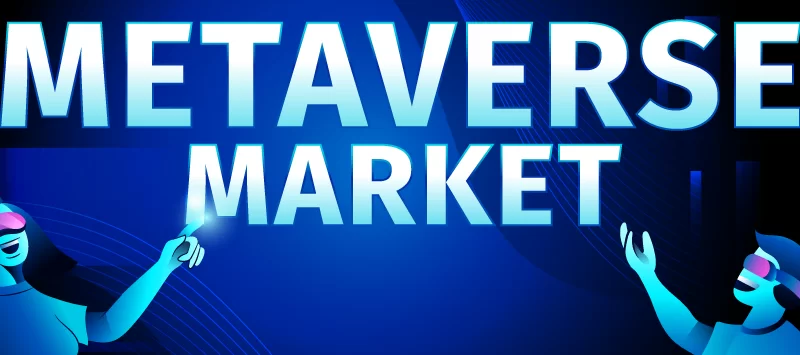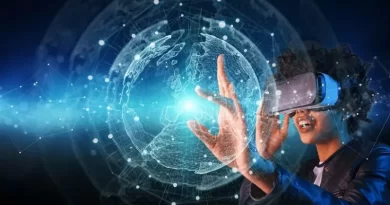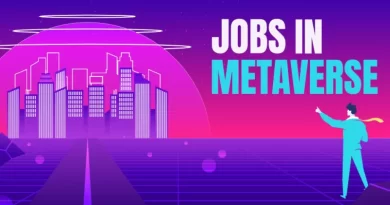Metaverse Market and Recent Developments
The metaverse, which fuses our physical reality with augmented and virtual reality, will usher in a 3D internet (AR and VR). At least, that’s what engineers and tech giants are working to build. In 2022, we may anticipate the metaverse to become more well-known due to businesses like Microsoft, Meta (previously Facebook), Epic Games, and Nvidia’s intense interest in it.
According to estimates, the worldwide metaverse market would be worth USD 426.9 billion by 2027, growing at a compound annual growth rate of 47.2%. (CAGR). In 2022, the metaverse market was worth USD 61.8 billion. Rising demand in the media and entertainment as well as the gaming industries, evolving opportunities from adjacent markets like Virtual Reality (VR), Augmented Reality (AR), Mixed Reality (MR), and digitalization in the art, fashion, and retail industries are some of the key factors anticipated to propel the growth of the metaverse market. These important features greatly increase the breadth, reach, and services of the metaverse to many businesses and end consumers. Additionally, the use of gamification and virtual world simulators by brands for their promotional campaigns has dramatically increased the demand for vendors in the metaverse market to redesign cutting-edge infrastructure, improve 3D environments, and provide a technologically driven ecosystem in order to provide end users with the best possible experiences and transactions.
COVID 19 Impact
In comparison to the pre-COVID-19 scenario, the metaverse market growth rate has marginally slowed down between 2020 and 2021, according to a MarketsandMarkets report. The operational difficulties extended reality (XR) device makers are currently facing are the main cause of the downturn. Despite the COVID-19 impact, we have seen a considerable number of opportunities emerge in the metaverse software sector. Two of the most notable ones are the implementation of XR-based solutions in the education sector and industrial training. The fully-tested deployment of XR in the healthcare sector continued and consistent improvements in 5G technology and businesses migrating from offline exhibitions to virtual video live streaming events are all probable future developments. In the upcoming years, it is projected that the metaverse market would expand.
Metaverse Buzz Words
Because the metaverse is still developing, many individuals find it difficult to understand how it works. However, its introduction is expected to open up new avenues for communication, employment, recreation, and even travel.
Digital Twin
A digital twin is a virtual representation of a real-world object or feature. This is one way that the metaverse is fascinating—you can be anybody you want in it. Your online identity will be represented by an avatar, which can either closely resemble you physically or assume entirely distinct traits.
Mirror World
Through headsets, glasses, and connected watches, the metaverse provides 3D settings. As a result, the metaverse functions as both a reflection of the existing world and a brand-new cosmos, enabling the construction of a futuristic reality with cutting-edge scenarios. This virtual reality is referred to as the “mirror world” by experts.
Mixed Reality
Total immersion in the metaverse is possible because of mixed reality (MR) technology, which blends VR and AR. Digital objects can communicate with both physical and virtual objects, and users can interact with both. With the use of a specific set of glasses or a helmet, VR allows for full immersion in the virtual world. Similar feelings are produced by a roller coaster simulation. A digital overlay casts pictures and graphics onto the real world in augmented reality. In Pokémon Go, figures are photographed in actual environments, which is a great example of augmented reality.
Non–Fungible Token
Non-fungible tokens are a brand-new class of virtual assets in the metaverse that has fueled much of its expansion. A digital, intangible object is an NFT. It might be a picture, a video, or something from the game. NFT owners are tracked on the blockchain. They can trade the digital assets they stand for as a result. These items are viewed as investments by some NFT collectors while cultural artifacts by others.
Blockchain
Blockchain is a crucial mediator in transactions in the metaverse. A network of computers that shares a database is referred to as a blockchain. Once a record is in the chain, it is extremely difficult to change it. The network continuously checks to make sure that every database copy is the same. Users can purchase, trade, or upgrade virtual goods including homes, weapons, and skins in virtual spaces thanks to the metaverse. A Grayscale article claims that $200 million has already been spent on metaverse goods.
Recent Developments
- GRID Legends, a multiplayer game that allows for fluid action, lets players plan the ideal multiplayer session, and lets players collaborate on stories with other racers, was released by Electronic Arts Company in February 2022. It enables users to browse for live events that meet their tastes, enter events in real-time, open design races using the Race Creator, or create a private lobby for users’ parties. Even enemies and friends can enter any career event in real-time, according to players.
- A streamlined tool for creating augmented reality (AR) dubbed “Spark AR Go” went into closed beta in December 2021. A beta version of the “Spark Augmented Reality (AR) Go” mobile software for Android and iOS cell phones has been released by Meta. The smartphone app was created by Meta to go along with its spark AR Studio Software Development Kit (SDK), a potent tool that enables webAR effects and 3D content on its roster of social media sites, including Facebook and Instagram. With the help of “Spark AR Go,” AR content producers can create, test, and post immersive experiences on Meta’s social media platforms, as well as monitor user performance metrics and get user feedback.
- NetEase Cloud Classroom, a platform run by Youdao that provides online classes to adults in China, was introduced in November 2021. It introduces around 100 free online training programs provided by Amazon Web Services to teach users best cloud practices for a variety of AWS services and products.
- Unity Simulation Pro, which enables programmers to unleash the full potential of scaled simulations, was introduced in November 2021. The ability of many Graphics Processing Units (GPUs) to render the same project simultaneously, either locally or in the private cloud makes it the only product developed from the ground up to enable distributed rendering. A modular and user-friendly node-based editor called Unity SystemGraph was created to model complex mechatronic systems. Any robotics system, as well as photosensors like cameras and lidar sensors, can be simulated by it.
- Microsoft unveiled Microsoft Mesh in April 2021, a unified holographic virtual collaboration experience powered by mixed reality software. Users can experience a shared 3D virtual presence with mesh-enabled apps on any platform, including VR headsets, smartphones, tablets, and PCs.




